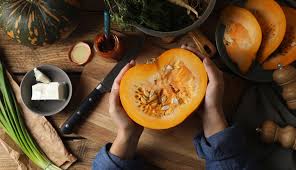Few things say “fall favorite” quite like pumpkin. Whether you’re enjoying pumpkin waffles for breakfast, sipping a pumpkin spice latte for an afternoon pick-me-up or finishing your meal with a slice of pumpkin pie, most of us can’t get enough of this seasonal flavor from October through December.
“Pumpkin has become synonymous with fall as its warm, earthy flavor is comforting and pairs perfectly with fall spices like cinnamon, nutmeg and cloves,” says Lisa Young, a registered dietitian nutritionist and author of “Finally Full, Finally Slim.”
Here’s what pumpkin is, why it’s good for you and when it might be wise to go easy on your favorite pumpkin-flavored recipes.
What is pumpkin?
Pumpkin is part of the Cucurbitaceae (gourd) family, “the same plant family that includes squash, melons and cucumbers,” says Young. Botanically speaking, it’s a fruit because it contains seeds. “But in culinary terms, it’s treated as a vegetable because it’s savory and is often used in soups, roasted dishes and other savory foods,” explains Dr. Uma Naidoo, director of nutritional and lifestyle psychiatry at Massachusetts General Hospital and author of “Calm Your Mind with Food.”
It’s also known for being squash-like in texture, mildly sweet and subtly earthy, especially when cooked. Raw pumpkin, on the other hand, tends to be fibrous, bland or even mildly bitter, which is why it’s rarely eaten that way except when grated or puréed with added flavorings or sweeteners.
Pumpkins come in many varieties, from large field pumpkins (great for carving) to smaller, sweeter “sugar pumpkins” that are ideal for baking and cooking. Pumpkins are available fresh, canned or even frozen. “Canned pumpkin (without added sugars) can be an especially great addition to recipes,” says Young. “It’s also good for the digestive health of dogs.”

